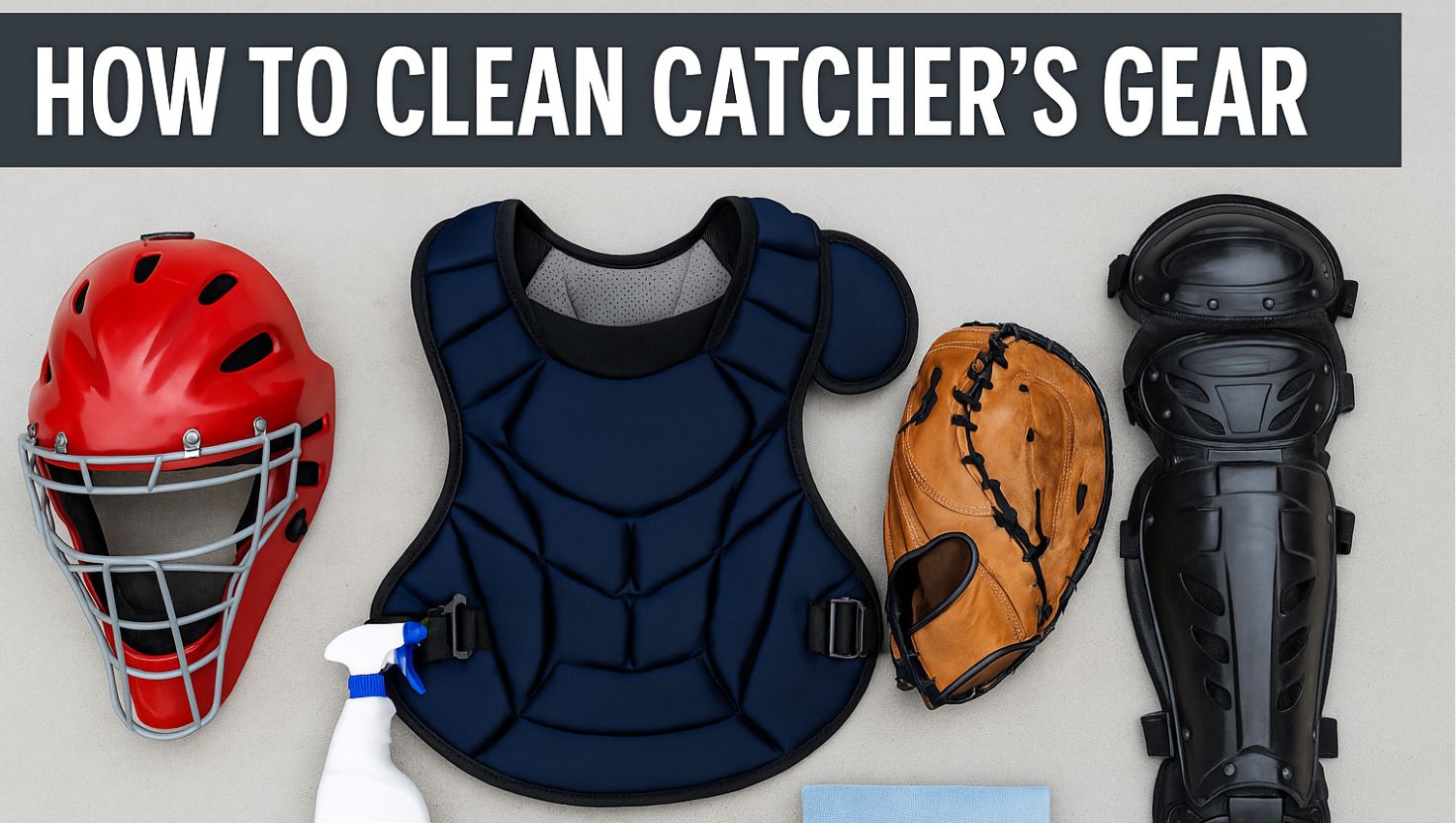The catcher’s gear is the all-time part and friend of the catcher in the catcher’s box. After a day-long game, your catcher’s gear gets dirt that needs to be cleaned.
You are a new catcher starting your career and don’t know how to clean catchers gear. Also, you might be your parent’s first kid who starts baseball.
A catcher’s gear includes a face mask, helmet, shin guards, chest protector, knee savers, and catcher’s mitt.
As the catcher’s gear is the most important equipment for the catchers, it must be kept clean. Clean catcher’s gear lasts long and gives a great performance,
Dirty gear will be damaged fast and lose performance as well. All parts of a catcher’s gear are not the same and need different treatment.
I will help you to learn how to wash catchers gear, whether it is softball catchers gear or baseball gear.
How to Clean Catchers Gear?

I will demonstrate how you can clean and wash catcher’s gear. Before that, there are things to be clarified. You might be thinking of using the washing machine to wash your gear. But is it really legit to do so?
Let’s get the answer first.
Before Starting Wash the Catcher’s Gear: Can You Use Washing Machine Wash?
Washing machine wash is a reliable and great way to wash fabrics. Unlike other fabrics, catcher’s gear should not be treated the same way. The catcher’s gear is mainly made of metal cages, leather laces, plastic shells, synthetic materials, and fabric layers.
So, most of the parts are out of fabric. Actually, that is not suitable for machine washing. Rather, serious catchers love manual washing.
So, you are requested to washing catcher’s gear by hand with a full manual washing process.
Even if you want to clean the catcher’s gear’s fabric part with the machine, make sure you strictly follow the manufacturer’s instructions. You will be amazed that even some manufacturers also recommend washing the fabric part by hand wash.
By the way, I will discuss each and every part of the catcher’s gear needs to be washed separately. It would also be easy to read and understand in such ways.
So, let’s start cleaning catcher gear which would mind refreshing things. Because clean things keep the mind refreshed.
See Also: How to Clean a Baseball Bat?
Part 01: Cleaning the Catcher’s Helmet
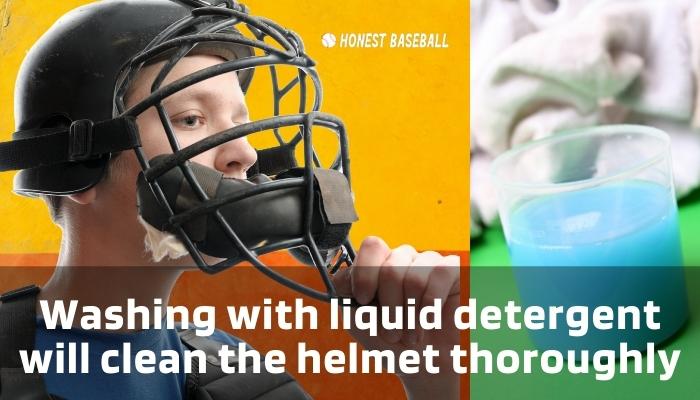
Let’s start with the easiest part of the catcher’s gear to clean. The catcher’s helmet is the easiest part to clean. Also, the helmet gets the least dirty as well.
But, one of the biggest problems with the catcher’s helmet is getting an odor. It’s a universal problem, tough to get rid of. As a result, you have to clean your catcher’s equipment regularly.
By the way, keeping antibacterial wipes could be a rough solution for the helmets to remove the odour. You can wipe the inside foam section with an antibacterial wipe to prevent any odor after each game.
By the way, it is not a permanent solution at all. It will become odd and dirty after every game. So, you need to clean your catcher’s helmet once every week.
Catcher’s Helmet Cleaning Process
our helmet and mask take a beating, blocking foul tips and keeping you safe. But all that sweat and grime can build up. Let’s get it cleaned up!
Step 01: The Exterior Shell: Wiping Away the Battlefield
Start with cleaning the dovetail halving of the helmet. You can use a moist cloth to do so. Use mild soap or mild detergent water with a sprinkler on the helmet’s surface. Rub the surface thoroughly to remove the leftover.
Dip your cloth or sponge in the warm, soapy water and gently wipe down the entire outer shell of the helmet. Pay close attention to those areas that tend to collect dirt and mud – you know, those stubborn splatters from around home plate.
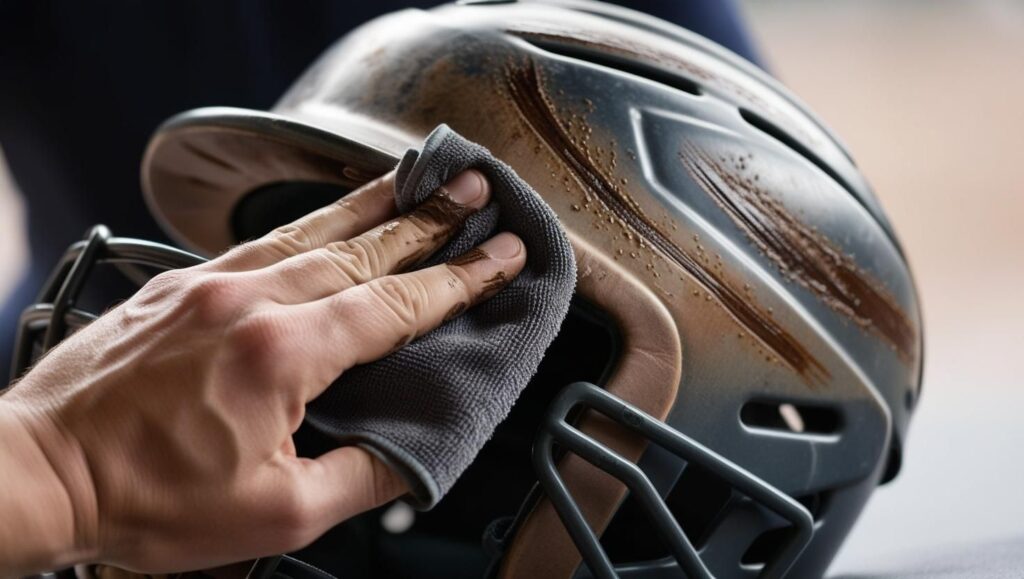
For those annoying scuff marks, you might need a little extra elbow grease. Keep using the soapy water and a bit more pressure, but be careful not to scrub so hard that you damage the finish.
Once you’ve wiped away all the dirt and soap, grab a clean cloth dampened with just plain warm water and wipe down the shell again to remove any soapy residue. Finally, use a clean, dry cloth to wipe the outer shell completely dry. Letting it air dry for a bit longer in a well-ventilated spot is also a good idea.
Step 02: Cleaning the Metal Cage
The cage on your mask can trap dirt and debris in its gaps. To clean it effectively, use a soft brush, like an old toothbrush, or even cotton swabs for tight spots. Start by dry brushing to remove any loose dirt.
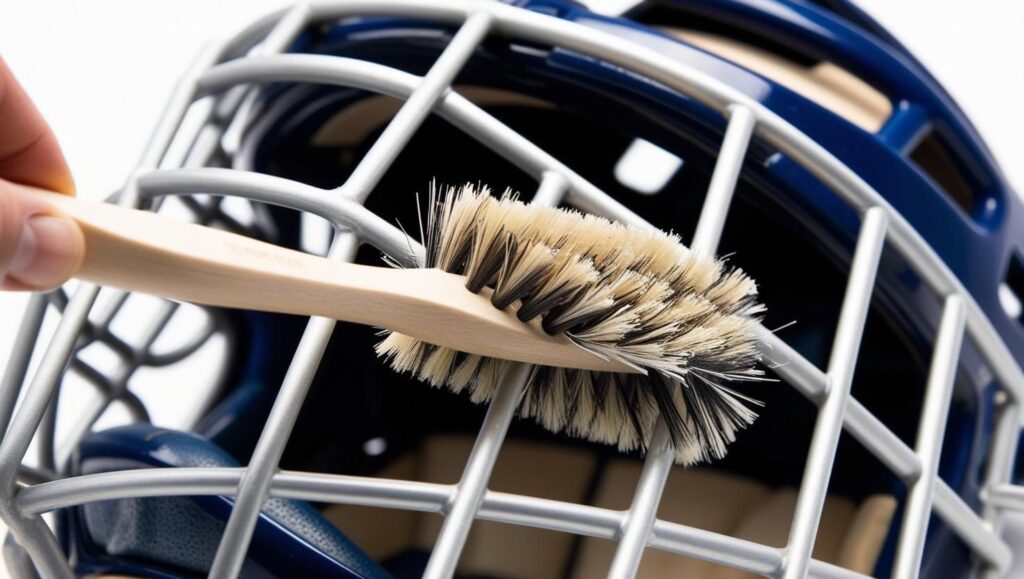
If needed, dip your brush or swab in warm, soapy water and gently scrub the bars and connections. Rinse away any soap with a clean, damp cloth or swab. Make sure the cage is thoroughly dry afterward to prevent rust.
Step 03: Cleaning the Interior Padding
But, another thing should be kept in mind. If the inner side of the helmet gets too much odor for sweating, it is good to wash the inner side.
The cleaning method depends on whether the padding is removable or not.
For Removable Padding: Carefully detach the padding from the helmet. Fill a sink with lukewarm water, add a little mild soap, and gently hand-wash the padding.
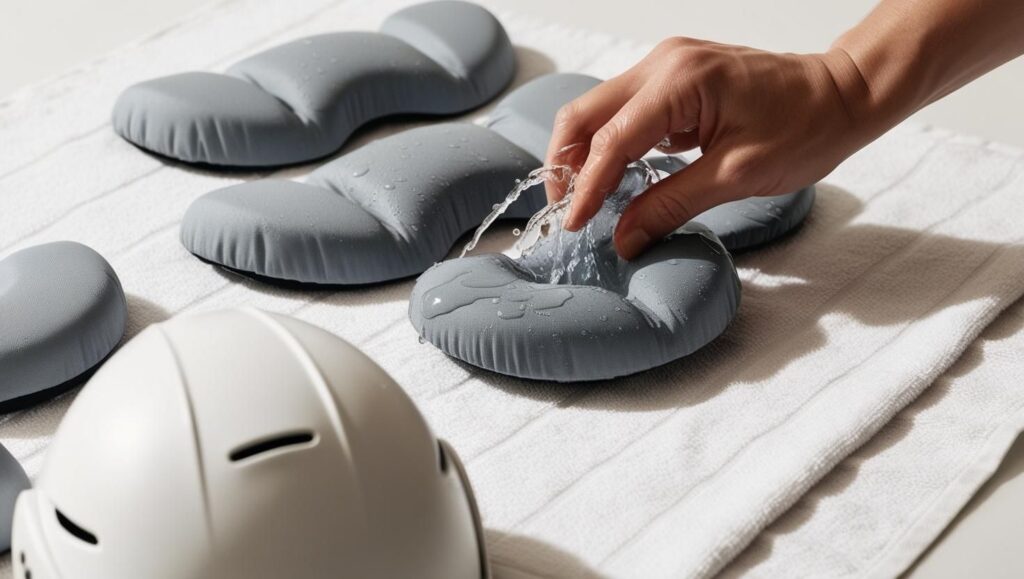
Rinse it thoroughly under clean water until all soap is gone. Gently squeeze out excess water (don’t wring), and lay the padding flat on a clean towel or rack to air dry completely. Do not use a dryer. Ensure it’s fully dry before reattaching.
For Non-Removable Padding: Take a soft cloth dampened with warm, soapy water and carefully wipe down all interior padding. Avoid soaking it. Follow with a clean cloth dampened with plain warm water to remove any soap residue. It’s crucial to let the helmet air dry completely in a well-ventilated area. Using a fan can help speed up the drying process.
Step 04: Cleaning the Helmet Straps
The straps that secure your helmet can also absorb sweat. For a basic clean, wipe both sides of the straps with a damp cloth and a little mild soap. Then, use a clean, damp cloth to rinse away the soap. If the straps are heavily soiled or smelly, you can hand-wash them gently in lukewarm water with mild soap, similar to removable padding. Rinse them well and lay them flat to air dry completely, avoiding the dryer.
Part 02: Cleaning Chest Protectors
The chest protector has mainly two-part. The comfortable inner part of foam and other protective fabrics. And the outer side is protected by a plastic layer.
The very first task is to depart the plastic and inner fabric portion by taking off the straps.
The Process of Cleaning the Chest Protector
You can use two methods for cleaning the fabric part of the chest protector: washing machine, as I mentioned before, or hand washes.
By the way, using a wishing machine would be a relief here, so you can do this.
Take warm water and pour it into the machine. Add the right portion of liquid detergent and throw off the fabric part of the chest protector inside it.
By the way, before tossing the fabric layer inside the washing machine, thoroughly get off the loose dirt.
Set time for 7 to 10 minutes. After washing the inner part, including the shoulder pads and strap, air dries it. Though you can machine wash, I will never recommend machine drying the fabric.
See Also: How to Wash a Baseball Cap?
Another Method for Cleaning the Chest Protector
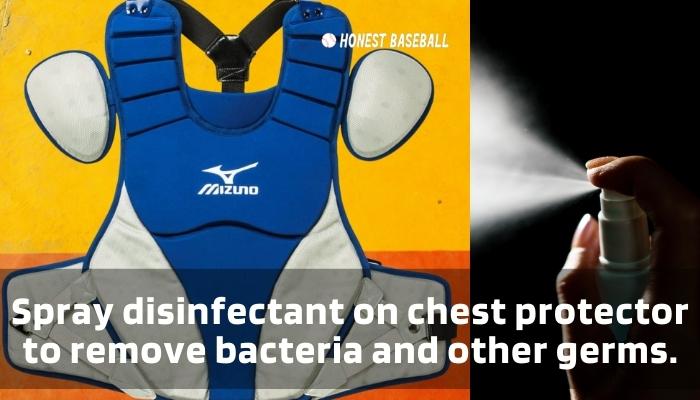
Aside from full washing, you can just disinfect your chest protector if there is not so much dirt. For this, first, remove the padding parts from the plastic shell of the protector.
Apply deodorizer spray to remove the odor from the protector. Here, the most important part of cleaning the chest protector is to disinfect it after washing properly. Spray the disinfectant all over the chest protector and leave it to dry.
Part 03: Cleaning the Catcher’s Mitt
Do you know what part is the most important to a baseball catcher? It is undoubtedly the catcher’s mitt or the catcher’s glove. Because the catcher’s glove is the tool that is constantly used and directly interacts with the ball.
On the other hand, being leather-made, the catcher’s glove needs the most care when you clean it because you cannot just use plain water solution or any liquid solution to clean it.
Here I will show you the cleaning process of a catcher’s mitt step-by-step.
Glove cleaning takes mainly two parts, cleaning and conditioning the gloves. Here are the steps you should take to properly clean your catcher’s mitt.
Along with a catcher’s mitt, the baseball glove is another important element for many hitters. Knowing how to clean baseball batting gloves would be another great thing to learn.
The Cleaning Process of Catcher’s Mitt/Glove

Scrubbing the Loose Dirt
The first step to cleaning the catcher’s mitt is to take off the loose dirt from the glove. For this, use a stiff bristle or a rough cloth. Scrub the glove wholly to make sure you remove all visible loose dirt.
Give attention to the palm of the glove. By the way, aside from a full cleaning, you should scrub your gloves after using them each time.
Opening the Leather Laces
To properly clean the debris and leftovers that reaches the deeper of the glove, you need to open the laces of the gloves. Though, sometimes the laces would be stuck so tight that you might need to cut them off.
If so, you will need a new set of laces to attach later.
By the way, if the dirt is too much and you need to remove the laces, do it. If needed, cut them off.
You can easily reach the deeper area of the gloves to clean the debris. So, clean each and every dirt you find.
Applying Cleaning Agent on the Glove for Final Finish
Now, it’s time to apply the cleaning agent to the glove. You can use a soft cloth to dab the agent on the glove. Depending on its construction, you have two options to dab the cleaning agent on the glove.
By knowing the manufacturer’s instructions, you can use the cloth circularly or the back-and-forth method.
- You need to properly use the cleaning agent. Make sure you don’t overuse it.
- After applying the cleaning agent, wait until the cleaning agent is entirely mixed and dried. You may need to wait up to one day.
Catcher’s Mitt Conditioning
Though cleaning and conditioning hold almost the same objective, conditioning gives more life to the glove if you do it on a regular basis.
Basically, conditioning the glove helps to keep the glove last longer. You can use glove oil or baseball oil cum conditioner to condition the glove.
By the way, the process of glove conditioning is as follows.
- Use a soft cloth like the cleaning agent, or you will get an in-boxed cloth with the baseball glove conditioner. Take some oil with the cloth and gently dab it on the glove.
Make sure you reach all areas on the glove by dabbing the conditioner. Keep the webbing and palm on the most important list. Don’t overuse the conditioner. - After dabbing the conditioner properly, leave your glove for 24 hours. Allow the glove to entirely absorb the conditioner and mix it on the entire surface of the glove.
- See, your glove grasped a new state and condition after applying the conditioner. It becomes soft and usable again. Regular conditioning helps your mitt to stay alive and perform for a long time.
Are you looking for the best catcher’s gear? Would yould check Evoshield Catcher’s gear once? It has some cool features.
Part 04: Cleaning the Shin Guards/Leg Guards
Cleaning the leg guard or shin guards is not that challenging. Even it is the easiest part of the gear to clean. If your shin guard is too dirty to use, you can wash it.
I prefer the washing if it is a long day you haven’t washed it. By the way, washing the leg guard is not that complex. Mainly, you should wash the synthetic foam-padded comfortable part inside the plastic shell outside.
The washing process is so simple. You just need to mix up mild soap or a mild detergent in warm water. Warm water means warm, not hot water.
Mix the solution properly and soak the synthetic foam part for 10 minutes. After soaking, now rub the leg guards with a soft cloth or a soft scrubbing brush.
Make sure you don’t rub this part roughly. Otherwise, it could be torn off. At least the synthetic net will be stuck.
By the way, after properly caring and washing, rinse the part so that no leftover sustains. Air dry the shin guard under the sunshine.
On the other hand, the upper plastic layer doesn’t need to be washed with water. Only using disinfectant will be just fine for this. Before spraying the disinfectant, take a clean cloth and remove all loose dirt from the plastic part of the leg guard.
The knee savers are also part of leg guards. They are made of foam and covered with plastic cover. You can easily wash the cover and inner foam with mild soap and water. The process is the same as the foam leg guard I have discussed.
Can You Paint Catchers Gear?
Many people ask whether they can paint catcher’s gear or not. In short, you can paint the hard part of your catcher’s gear. For example, the hard part of the helmet, the cage of face masks, the plastic portion of the leg guards, etc.
But, we don’t recommend painting the soft parts like the synthetic covers, foam, pads, etc. It will surely be a mess, no doubt.
Washing the Catcher’ Gear Bag
You shouldn’t forget your catcher’s bag after washing and cleaning all of your catcher’s gear. The catcher’s bag could easily be got smelled due to carrying your catcher’s gear.
On the other hand, continuous use will make it dirty naturally. So, you also should wash your catcher’s bag to get rid of bad smells and dirt.
Washing the catcher’s bag also follows the same process as the synthetic part of the catcher’s gear.
Process of Washing Catcher’s Bag
- Start with making the bag empty. Make sure there is nothing inside the bag.
- Use a brush to scrub the bag before washing. Make sure there is no extra loose dirt on the bag.
- Now, make the soap and water solution by using mild soap or mild liquid detergent.
- Soak the bag in soapy water after properly mixing the soap and water.
- Leave the bag for 20 minutes.
- Use a bristle brush to scrub the bag and remove all dirt from it.
- After cleaning all specks of dirt, rinse the bag with clean and cold water and air dry the bag.
Note: If it is a large duffel bag, you can wash it using the washing machine. But it is not recommended to use the washing machine if your bag is a wheeled bag.
Make sure all the stench has gone before drying the bag.
Read More: A detailed guide on “How to Wash a Jansport Backpack
Storing Your Catcher’s Gear
In the off-season, you must store your catcher’s gear so that they stay safe and do not get damaged. It is important because you shouldn’t purchase a new set of gear every season.
Here are some tips for storing your gear without getting damaged.
- Store somewhere where the place is dry and cool. But ensure the place is clean too.
- Make sure the place gets proper ventilation.
- Don’t keep your gear in such a place that is cramped. For example, don’t keep them in a locker or inside a bag. They will get bad smelled and will be damaged.
Frequently Asked Questions
How to clean baseball batting gloves?
Cleaning baseball batting gloves are not that challenging. As they’re not leather but rather made of washable materials, you can directly wash them, which is more efficient too.
Simply mix up mild washing detergent with warm water and soak the batting gloves for minutes. Take the gloves and scrub them back and forth.
After cleaning properly, rinse then with clean water and dry.
How to clean softball gear?
Cleaning softball gear and baseball catcher’s gear has no differences. As I have discussed the catcher’s gear above, you can follow the process from there.
- What tools are needed to clean catchers gear?
Here is a list of the required tools for cleaning your catcher’s gear.
- Bristles or shoe brush.
- Clean cloths.
- Mild detergent or liquid soap.
- Leather cleaning agent, etc.
- How to keep bad smell away from my catcher’s gear?
The organic way to keep your gear good smelled is to clean them regularly. There are several cleaning methods. Along with cleaning, you also can use deodorizer spray on your gear to keep bad smells away.
Wrap Up
Cleaning the catcher’s gear prolongs its usability. That is why you need to know how to clean catchers gear properly.
Each and every part of the catcher’s gear demands special care. Cleaning catcher’s gear in the right way will help you to keep them last longer.
Clean leg guards, chest protectors, and the catcher’s mitt thoroughly. Follow the instruction of the glove manufacturer before cleaning the catcher’s glove.
Use glove oil and petroleum-based cleaners to keep them prolonged.
As long as using the manual washing process, you also need to ensure some more care for them.
Don’t keep the gear wet. Use deodorizer spray to keep the bad smell away.
You May Also Like:
Mizuno Softball Catchers Gear Review
How To Break In A Catcher’s Mitt
Easton Force Catchers Gear Review | Learn Every Parts Of The Set
7 Top Catchers Bags | Put All Your Gear In A Single Catcher’s Bag

Hello everyone. My name is Jason Butler, and I live in California, America. I was a professional AAA Minor League Baseball player. I lost my chance of playing MLB for injury issues, but I did not lose my love for baseball. I attended the coaching training program and am now working as a coach in a small school in San Diego.
I always love to share my experience and knowledge if that can help you. Play baseball, and stay fit.
